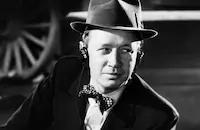Rainbow Island
Brief Synopsis
Cast & Crew
Ralph Murphy
Dorothy Lamour
Eddie Bracken
Gil Lamb
Barry Sullivan
Forrest Orr
Film Details
Technical Specs

Synopsis
During World War II, Merchant Marine Toby Smith tells his shipmates the true story of what happened to him the previous summer: While sailing out from Australia, Toby's ship is torpedoed and he, bosun Pete Jenkins, and radio officer Ken Masters are marooned on a nearby island. After thirteen days, a Japanese plane lands on the island and the three Merchant Marines capture the Japanese and steal their plane. They are shot down, however, by an American battleship and are stranded on another island. The second island is occupied, however, and Dr. Curtis, an American physician who had been shipwrecked there years earlier with his daughter Lona, advises the queen of the islanders, Queen Okalana, that the plane is evil as it comes from the land of the "Rising Sun." When Toby, Pete and Ken revive from the crash, they are surrounded by beautiful English-speaking island women. Queen Okalana deems that Toby, Pete and Ken should be executed but Toby squirms so much that the executioner is unable to chop his head off, and Lona suddenly sees a resemblance between Toby and a carving of their sacred god, Momo. The execution is halted, and Toby is hailed as a god. He then saves Pete and Ken by dubbing Pete, "Twerpo," his slave, and Ken, "Gogo," the master mechanic of the "iron bird." Lona falls in love with Ken and threatens to reveal Toby's true identity to her people unless Ken agrees to let her leave the island with them. Lona performs a dance during which she places a flower lei on Ken and tells him to respond with a kiss. Lona's jealous fiancé Alcoa picks a fight with Ken, but when Ken strikes him, his ring leaves an imprint on Alcoa's chin, and Dr. Curtis claims it is the mark of "Momo" so that the islanders will back off. Alcoa and high priest Kahuna are determined to prove that Toby is not a true god, as any man who pretends to be a god will be executed by a man-eating plant. Each time Toby comes close to revealing his human foibles, such as eating, he is saved by sheer luck, or Pete's ingenuity. Dr. Curtis advises a lovesick Lona to proceed with her marriage to Alcoa in order to make Ken jealous. When Queen Okalana is shown a set of spark plugs from the plane, she becomes suspicious that a god needs machinery in order to fly, and wears the plugs as a necklace. During Lona's premarital rite of purification, Ken realizes that he has fallen in love with her, and that night, he romances her and urges her to get the necklace from the Queen while she sleeps. Lona is about to carry out her mission when she is caught by Alcoa, who insists on placing her under protective guard. Ken then reluctantly romances Moana to induce her to steal the necklace, but Lona overhears his overtures and ruins Ken's plans. Toby then dresses up as a island woman and convinces the Queen's guards that she has sent for him. Pete, meanwhile, digs a tunnel under the fence around the queen's compound as an escape route. Unfortunately, he comes up between Kahuna and the guard Akana. By this time, Toby has administered a sleeping potion to the queen and the islanders believe she has died. Alcoa gives Toby until sunrise to prove that he is a god and revive the queen. He fails, and the next morning, he is tied up on a funeral pyre to burn alongside the queen. Curtis convinces Lona that Ken's intentions toward her were honest, and that he only used Moana to help free them all. Curtis cuts the ropes around Toby's hands as the pyre is lighted, while Toby grabs the spark plugs. The islanders are astonished when the queen finally awakens, and the three Merchant Marines, plus Curtis and Lona, run for the plane. To give Ken time to start the plane, Toby and Pete allow themselves to be chased by the islanders. Ken and Alcoa fight until Lona knocks Alcoa out with a monkey wrench, after which the plane takes off with the sailors. Toby concludes his tale by noting that they were picked up by an American cruiser. As proof of his story, Toby offers a photograph of Lona, but the sailors recognize her as actress Dorothy Lamour, and Toby affirms that this is how she got into the movies.

Cast

Dorothy Lamour

Eddie Bracken
Gil Lamb

Barry Sullivan
Forrest Orr

Anne Revere
Reed Hadley
Marc Lawrence

Olga San Juan
Adia Kuznetzoff
Elena Verdugo
George Urchell
Robert Martinez
Hannah Kaapa
Danny Stewart
The Hopkins Twins
Stanley Price
Aggie Auld
Renee Dupuis
Iris Lancaster
Lena Belle
Virginia Lucas
Audrey Young
Louise Laplanche
Pua Kealoha
Alex Havier
Dan Seymour
Theodore "pete" Rand
Satini Puailoa
Robert St. Angelo
Rod Redwing
Baudelio Alva
Rudy Masson
Alexander Mcsweyn
Alex Montoya
Leigh Whitney
Nonny Parsons

Yvonne De Carlo

Noel Neill
George T. Lee
Leon Lontoc
Jimmie Lano
Carmen D'antonio
Luis Alberni
Bobby Barber
Allen Fox
Frank Marlowe
Bob Stephenson

Eddie Acuff
Larry Thompson
Frank Wilcox
Paul Mcvey
Ralph Linn
Crew
Robert Brower
Danny Dare
Walter Deleon
B. G. Desylva
Haldane Douglas
Hans Dreier
Farciot Edouart
Harve Foster
Arthur Franklin
Augie Goupil
Edith Head
Gordon Jennings
Natalie Kalmus
Ted Koehler
Burton Lane
E. D. Leshin
Joseph J. Lilley
Jimmy Lono
Germaine Marshall
Walter Oberst
Seena Owen
Arthur Phillips
George Sawley
Arthur Schmidt
W. C. Smith
Karl Struss
Roy Webb
Wally Westmore

Film Details
Technical Specs

Articles
Rainbow Island (1944) - Rainbow Island
Lamour had made a career out of tropical musicals, belting out hits while looking beautiful and wearing a sarong designed by Edith Head. Rainbow Island continued that formula. It was a bright Technicolor musical designed to show off Lamour's figure in the sarong while she sang the Ted Koehler/Burton Lane song Beloved, and make them forget, for 90 minutes, that the United States had been at war for two years. Directed by Ralph Murphy, the film was based on a story by Seena Owen, who had been a star in the silent film days, most famously in D.W. Griffith's Intolerance (1916) and had turned to writing. The screenplay was adapted by Arthur Phillips and Walter DeLeon. In it, Lamour plays Lona, a doctor's daughter who has been raised on an island, and encounters three American seamen who are hiding there from the Japanese. One of the seamen is mistakenly thought to be a god and the trouble begins.
In the cast with Lamour was Eddie Bracken, Paramount's young comedy star, Gil Lamb, and, oddly cast, respected dramatic actress Anne Revere as the Queen of the Island. As Jeanine Basinger wrote in The Star Machine, "She had won the Academy Award for Best Supporting Actress in 1944 for her role as Elizabeth Taylor's mother in National Velvet. And yet that very same year, she was cast as the queen of a south seas island in Rainbow Island [...] Revere is photographed standing around in a sarong, wearing lotus blossoms in her hair and yards of bangles on her arms. She strides through the jungle carrying a decorative spear and delivering such lines as 'Bring them to the temple of Moh-Moh.'" In the August 21, 1943 edition of Billboard Magazine it was reported that producer Buddy DeSylva was going to put Johnnie Johnston in the lead role opposite Dorothy Lamour. Johnston did not appear in the film, but Barry Sullivan did. Two of the girls playing Lamour's companions were Yvonne De Carlo and future Superman star, Noel Neill.
Released on September 5, 1944, Rainbow Island was seen for being exactly what it was. New York Times critic Bosley Crowther pointed out that Paramount was recycling the Road formula, but wished that "the script were better and Bracken and Lamb were Crosby and Hope. Well, everything can't be expected....Miss Lamour -- back to saronging -- gets the most out of what she has...Mr. Bracken makes a very balmy comic, and when he is on the screen, there is constant cause for amusement, if only to look at him...A scene in which Mr. Bracken, as the god, gives paternal advice to a maiden on how to please a husband is truly sidesplitting stuff....Mr. Sullivan fits into the picture as a romantic second-lead should, and Miss Lamour moans one song, Beloved,...But it is mainly the job of Mr. Bracken that makes it worth going to see."
Producer: E.D. Leshin
Director: Ralph Murphy
Screenplay: Walter DeLeon, Arthur Phillips; Seena Owen (story)
Cinematography: Karl Struss
Art Direction: Haldane Douglas, Hans Dreier
Music: Roy Webb
Film Editing: Arthur Schmidt
Cast: Dorothy Lamour (Lona), Eddie Bracken (Toby Smith), Gil Lamb (Pete Jenkins), Barry Sullivan (Ken Masters), Forrest Orr (Dr. Curtis), Anne Revere (Queen Okalana), Reed Hadley (High Priest Kahuna), Marc Lawrence (Alcoa), Adia Kuznetzoff (Executioner), Olga San Juan (Miki).
C-98m.
by Lorraine LoBianco
SOURCES:
Basinger, Jeanine The Star Machine
"Coast Running Swoonstakes, Casting Every Bary - And, in One Case, His Brother Billboard 21 Aug 43
Crowther, Bosley, "'Rainbow Island,' With Bracken and Lamour Opens at Criterion", New York Times 26 Oct 44
Green, Stanley and Schmidt, Elaine Hollywood Musicals Year by Year
The Internet Movie Database

Rainbow Island (1944) - Rainbow Island
Quotes
Trivia
Notes
Seena Owen's original story was titled "Down Where the Trade Winds Blow." Hollywood Reporter news items report the following about the production: Frank Tuttle began directing the film but withdrew in early November 1943 due to illness, and was replaced by Ralph Murphy. Dorothy Lamour initially turned down the part until it was rewritten. Betty Rhodes, Johnnie Johnston and John Conte were considered for lead roles, and Twentieth Century-Fox loaned Reed Hadley for this film.














